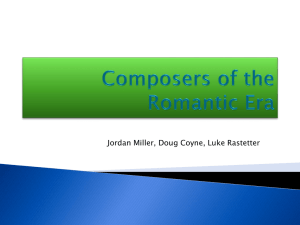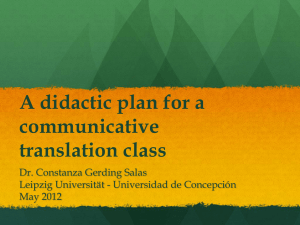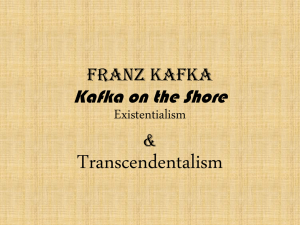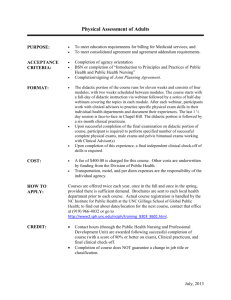The American Institute of Medical Education
advertisement
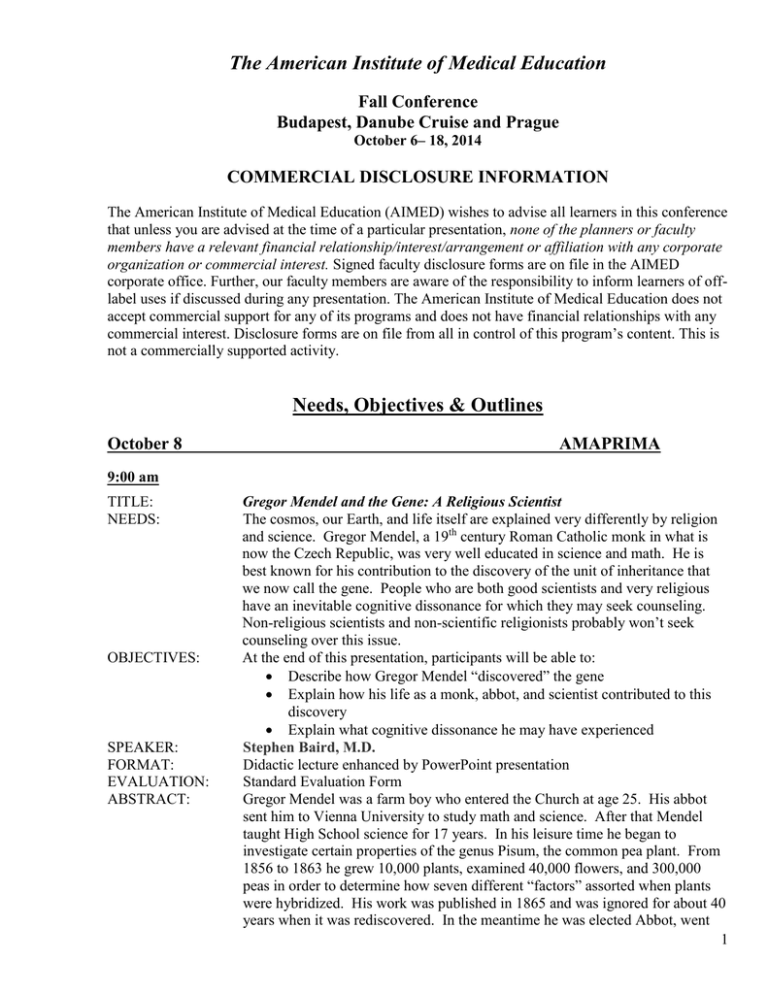
The American Institute of Medical Education Fall Conference Budapest, Danube Cruise and Prague October 6– 18, 2014 COMMERCIAL DISCLOSURE INFORMATION The American Institute of Medical Education (AIMED) wishes to advise all learners in this conference that unless you are advised at the time of a particular presentation, none of the planners or faculty members have a relevant financial relationship/interest/arrangement or affiliation with any corporate organization or commercial interest. Signed faculty disclosure forms are on file in the AIMED corporate office. Further, our faculty members are aware of the responsibility to inform learners of offlabel uses if discussed during any presentation. The American Institute of Medical Education does not accept commercial support for any of its programs and does not have financial relationships with any commercial interest. Disclosure forms are on file from all in control of this program’s content. This is not a commercially supported activity. Needs, Objectives & Outlines October 8 AMAPRIMA 9:00 am TITLE: NEEDS: OBJECTIVES: SPEAKER: FORMAT: EVALUATION: ABSTRACT: Gregor Mendel and the Gene: A Religious Scientist The cosmos, our Earth, and life itself are explained very differently by religion and science. Gregor Mendel, a 19th century Roman Catholic monk in what is now the Czech Republic, was very well educated in science and math. He is best known for his contribution to the discovery of the unit of inheritance that we now call the gene. People who are both good scientists and very religious have an inevitable cognitive dissonance for which they may seek counseling. Non-religious scientists and non-scientific religionists probably won’t seek counseling over this issue. At the end of this presentation, participants will be able to: Describe how Gregor Mendel “discovered” the gene Explain how his life as a monk, abbot, and scientist contributed to this discovery Explain what cognitive dissonance he may have experienced Stephen Baird, M.D. Didactic lecture enhanced by PowerPoint presentation Standard Evaluation Form Gregor Mendel was a farm boy who entered the Church at age 25. His abbot sent him to Vienna University to study math and science. After that Mendel taught High School science for 17 years. In his leisure time he began to investigate certain properties of the genus Pisum, the common pea plant. From 1856 to 1863 he grew 10,000 plants, examined 40,000 flowers, and 300,000 peas in order to determine how seven different “factors” assorted when plants were hybridized. His work was published in 1865 and was ignored for about 40 years when it was rediscovered. In the meantime he was elected Abbot, went 1 into administration, and gave up active investigation, a well-known pathway in academic science. Unlike Galileo, who was forced by the Inquisition to recant the Copernican solar system, which he had defended, Mendel probably escaped condemnation because almost nobody read his work and those that did had no biological frame of reference to make sense of it. 10:00 am TITLE: NEEDS: OBJECTIVES: SPEAKER: FORMAT: EVALUATION: ABSTRACT: The Life of Viktor Frankl: Beyond Resilience Many patients present with depression and anxiety related to perceived or real losses. A loved one may have died, a chronic or terminal illness is diagnosed, dislocation due to job loss or divorce, or the need to face a traumatic childhood are just some of the life experiences that result in grief and even suicidal thoughts. Patients have questions about handling grieving feelings, about the meaning of suffering and one’s purpose in going on living. Understanding extreme loss, as in Frankl’s case, and learning about how his existential philosophy and therapy can help clinicians in their work to help these patients be inspired to see meaning in their own lives and recognize their purpose. At the end of the presentation, participants will be able to: List the three main components at the heart of Dr. Frankl’s treatment philosophy Compare Existential Analysis with Freudian Psychoanalysis Learn ways of discussing spirituality and values with traumatized patients. Understand the strengths-based approach to treating trauma and supporting patients’ resilience Gail Carr Feldman, Ph.D. Didactic lecture, Power Point including musical examples. Standard Evaluation Form This talk documents the life achievements of psychiatrist, Viktor Frankl, from childhood, his work throughout medical school, the programs he instituted while in the Theresienstadt Ghetto, and later in the concentration camps affiliated with Dachau. It also describes the evolution of his philosophy of surviving trauma and treating suicidal depression. The theme is related to his discovery in the death camps of what makes life meaningful as outlined in his classic book, Man’s Search For Meaning. His commitment to the idea that it is the mature person’s responsibility to find meaning in his life, regardless of circumstances, is echoed in Erik Erickson’s book, Insight and Responsibility. Dr. Frankl’s insistent focus on the importance of spirituality in treating those who are traumatized is eloquently described in his two books, The Doctor and the Soul, and The Unconscious God: Psychotherapy and Theology. His creation of Logotherapy, later called, Existential Analysis and his support of Humanistic psychology is also explained. 11:15 am 2 TITLE: NEEDS: OBJECTIVES: SPEAKER: FORMAT: EVALUATION: OUTLINE: Alma Mahler: Loss of Father during adolescence and its Effect on Subsequent Development Loss of a father during childhood or adolescence often causes great emotional strain and greatly affects subsequent emotional and sexual development. The clinician should be aware of these issues so he or she can help patients encountered in clinical practice who have experienced this loss as well as patients who have assumed the parental role following such a loss. At the end of this presentation clinicians will be able to: Identify and list 3 signs that a patient has suffered loss of a parent during childhood or adolescence Explain the effects of this loss on subsequent behavior in the patient’s emotional, mental and physical life. Describe in what ways artistic expression is therapeutic. Discuss resources and tools available to the patient Jacqueline Berz-Panter, MA, MS Didactic lecture with PowerPoint presentation Standard evaluation form I. Brief bio of Alma Mahler II. Discussion of parent loss a. From the psychiatric and psychological literature b. Application to the life of Alma Mahler III. Character traits a. Seductive b. Sexual c. Attraction to older men i. Klimt ii. Gustav Mahler IV. Reaction a. Walter Gropius b. Franz Werfel V. Clinical vignettes VI. Psychotherapeutic implications a. Focusing on behavior b. Focusing on unconscious organizing principles VII. Summary and Conclusions 12:15 pm TITLE: NEEDS: The Poetry and Music of Leonard Cohen: From Darkness to Light through Discipline As practitioners, we use many tools to help patients unlock and untangle the numerous emotional and psychological knots binding them to self-destructive patterns of behavior and poor interpersonal relationships. An especially difficult person to work with is one suffering from severe depression, which was biologically inherited from a parent. Not only was Cohen biochemically targeted, he also had the functional aspect of watching his mother’s daily struggle with this condition. I will demonstrate how this condition affected his interpersonal relationships and his work. Leonard Cohen chose to self-medicate and did not elect to have the benefits of a solid long-term psychoanalytic 3 OBJECTIVES: SPEAKER: FORMAT: EVALUATION: OUTLINE: treatment. I will explore how he chose a life of discipline as a method of counteracting his depression and how this component can factor in to treatment plans for clients and patients. At the end of this presentation, participants will be able to: Discuss the damaging effects of depression List 3 ways depression can interfere with one’s deep interpersonal relationships Using Leonard Cohen’s creative process, describe how he overcame his depression by means of living an extremely disciplined life Marlene Gershman Paley, Ph.D. Didactic lecture enhanced by animated clips. Standard Evaluation Form I. II. III. IV. V. October 10 Biography of Leonard Cohen with emphasis on depression Exploration of Leonard Cohen’s creative process Leonard tries to deal with depression on his own through discipline The lack of trust which prevented him from benefitting from psychiatric intervention to better help him develop constructive intimate relationships Conclusions AMAPRIMA 9:00 a.m. TITLE: NEEDS: OBJECTIVES: The Hero’s Journey of the Intuitive Mind: Thriving in a world biased for the logical and linear Highly intuitive people frequently seek psychotherapy for a similar cluster of symptoms: feeling anxious and emotionally overwhelmed; frustration from having set extraordinarily high standards for themselves; critical self talk; destructive behaviors with food, alcohol, sex, porn, work, or drugs; a tendency to feel they are stuck or behind where they should be in their life; chronic lateness and disorganization; fears of being exposed as a fraud; and an early experience of feeling different from others around them that can persist to the present day. They often recall being told that they were too sensitive, daydreamers, or worse. Using a bit of mythology and themes from the Hero’s Journey we will explore a deeper understanding of how, as intuitive people, we were deeply invalidated by a cultural bias for logical and linear thinking, the resulting harm to our psyche and esteem, and how we can reclaim our birthright to inner wisdom and wholeness. At the conclusion of the presentation, participants will be able to: Compare a positive definition for intuition with a definition of logical thinking and typical definitions found in the dictionary for intuition List the Nine Traits of An Intuitive Mind Explain how The Invalidation Wound happens, how it affects intuitive people, and why it leads to the cluster of systems typically seen in highly intuitive and creative people who present for treatment in our offices 4 SPEAKERS: FORMAT: Explain the basic idea of Joseph Campbell’s Mono Myth and understand how and why the Hero’s Journey becomes enacted in the lives of intuitive and creative people Give an Example of two types of an Externally Organized Self Structure Michelle Miller Bohls, LMFT Didactic lecture enhanced by a Prezi or PowerPoint presentation, short video clips, and elements from mythology OUTLINE: I. II. III. IV. V. VI. VII. VIII. IX. X. Definition and Etymology of Intuition Joseph Campbell’s Mono Myth and The Hero’s Journey a. The Invalidation Wound The Emperor’s New Clothes Invalidation at home, church, school & in the media External Organization of Self Esteem Clusters of symptoms arising from this adaptation The Wanderer’s Mythology a. The Nine Traits of An Intuitive Mind The Hero’s Call to Action Summary and Conclusions Questions and Answers 10:00 am TITLE: NEEDS: OBJECTIVES: SPEAKER: FORMAT: OUTLINE: King Ludwig II of Bavaria The "Mad" King Without basic nurturing, an infant does not acquire some of the essential developmental needs, such as self and other differentiation, object constancy and object permanence. Add to that the intermarriage among close relatives, typical of the Wittelsbacks and other royalty of Europe, and you have a particularly vulnerable genetic inheritance. Ludwig is a prime example of such a person. Isolated from other children, alternately coddled (by caretakers) and punished harshly (by father). Ludwig grew up socially uncomfortable, egocentric (his tutors told him he was "chosen by God"), lonely and deeply introverted. On the other hand, Ludwig was very bright, had an excellent memory, a great imagination. On the continuum from neurotic, through borderline to autistic, Ludwig would probably fit between borderline and autistic, closer to the former. At the end of this presentation, participants will be able to: Discuss this continuum and the elements of child rearing that contribute to maladaptive personality development. Explain issues of idealization and projection, as we watch Ludwig "become" in his own mind, Lohengrin, Tannhauser and Parsifal, characters from the murals surrounding him. List 3 possible treatments of such a person today Marlene Eisen, Ph.D. Didactic Lecture with power point, followed by discussion. I. The Wittelsbacks, Bavaria's royal family A. Grandfather, Ludwig 1 5 B. Father, Maximillian 11(age 36) C. Mother, Crown Princess Maria(19) D. Brother Otto E. Royal intermarriages created may genetic eccentricities II. Ludwig's childhood(Born, August 25, 1845) A. Parents B. Isolation C. First teacher, Sybille Miilhaus D. Saw his first opera, Lohengrin (1857) age 12, E. Later tutors F. Favorite activities III. Ludwig, II King of Bavaria A. Became king at 18 (1864) at death of his father. B. Met Richard Wagner (1864) C. Personal characteristics as king D. Avoided administrative and ceremonial duties E. Built beautiful castles, towers, gardens F. Died, June13, 1886 in Lake Sternberg IV. Psychodynamic Evaluation A. Early psychological impact B. Lack of object constancy/object permanence C. Isolation D. Schizoid symptoms E. Treatment 11:15 am TITLE: NEEDS: OBJECTIVES: SPEAKER: OUTLINE: From Darkness to Light Many natives in Fiji lose their near vision because of untreated Presbiopia, which is loss of near vision when over 40 years of age. Also very progressed Cataracts are prevalent causing serious chronic disappointment and depressive disorders. The Fiji Islanders are have many religions that teach that there are answers to prayer and believe this prayer for vision is not being answered. This presentation explores the journey from Darkness to Light and how depression lifts as a result of treating the physical, spiritual and mental concurrently. At the end of this presentation, participants will be able to: Discuss the relationship between religious beliefs and physical, emotional and mental disorders Explain how moving from darkness to light can be applied when treating patients for conditions of disappointment and depression Discuss how to apply these principles to clinical practice. Jerold Beeve, M.D. I. II. III. IV. First experience of answer to prayer Photo journal Videos Conclusion 12:15 pm 6 TITLE: NEEDS: OBJECTIVES: SPEAKER: FORMAT: EVALUATION: ABSTRACT: October 12 Beethoven’s Deafness: The Triumph of Creativity over Adversity Mental health professionals are often confronted with the task of helping patients cope with devastating loss. The onset of deafness is potentially catastrophic, particularly for a musician. The story of how the composer Ludwig Van Beethoven transcended his hearing loss in order to further his artistry can help patients who are searching for inspiration to help them grapple with adversity. At the end of this presentation, participants will be able to: Describe the connection between mental illness and creativity. Discuss the range of potential coping mechanisms in response to loss. Explain the impact of childhood trauma on adult development. Barry M. Panter, M.D., Ph.D. Didactic lecture and Power Point presentation Standard Evaluation Form No composer has ever surpassed Ludwig Van Beethoven in his extraordinary ability to express the full range of human experience – anxiety and aggression as well as triumph and transcendence. Beethoven endured an almost unimaginable obstacle for a musician – he lost his ability to hear. Anguished by his loss of aural contact with the world, Beethoven withdrew from social relationships and contemplated suicide, but he eventually found his salvation through creativity. “I have been hopelessly affected”, Beethoven wrote in his Heilgenstadt Testament. “I would have ended my life. It was only my art that held me back. It seemed to me impossible to leave the world until I had brought forth all that I felt was within me. So I endured this wretched existence.” In his deaf world, Beethoven was liberated from the musical styles and conventions of his time and he composed his greatest masterpieces as he withdrew into the world of his imagination. AMAPrima 4:00 – 6:00 pm TITLE: NEEDS: FORMAT: Discussion Group The interactive discussion group will give the participants an opportunity to share and discuss on a deeper and more detailed level the important psychosocial lessons taught in the morning lectures and so help them remove obstacles they might face in treating their patients. The Discussion Groups will be used to actively involve the participants in handling the concepts and principles presented, and to allow for greater elaboration and refinement of points made earlier. Interactive group discussion led by faculty 7 October 15 The Mark, Prague 9:00 am TITLE: NEEDS: OBJECTIVES: SPEAKER: FORMAT: EVALUATION: ABSTRACT: The Mind Of Kafka Every person has enigmatic features, which may impact the therapeutic interaction, so it is essential to observe and gently explore these aspects of human life. Given this, we will explore the prototypic existentialist enigma, Franz Kafka, fin de siècle observer, philosopher and writer during a time when there was a widespread belief that civilization leads to decadence, a belief which resurfaced at the end of the last century. The political themes during Kafka’s lifetime are thought to have given rise to fascism as a revolt against liberal democracy and materialism, again, a current concern. Against this backdrop, Kafka lived a life of contradictory exploration, alienated from family, friends, countrymen and self, saying that he didn’t have anything in common with his fellow Jews, because he didn’t feel that he even had anything in common with himself. We make assumptions/diagnoses about our patients based on our extensive education, clinical training and experience, but eliminating the bias of our own projection is a challenge, as each of us has lived a life with various degrees of Kafkaesque experiences. These experiences change us by causing us to reframe prior assumptions/illusions and evolve to newer assumptions/illusions. Recognizing this process in ourselves helps us gain insights into ourselves to help our patients. It is said that Kafka was probably “schizo-affective” by inference, of course. I will offer a phenomenological description of this man, not to “diagnose”, but rather discuss his short life as a series of adjustment reactions to hostile indifference and absurdity, leading to anxiety, withdrawal and sadness, culminating in a horrible death from tuberculosis. We find ourselves in a world no less hostile, indifferent or absurd, so we may consider our non-psychotic patients to have similar adjustment reactions. Perhaps our patients would feel “understood”, rather than labelled as “depressed”, “bi-polar” or “schizo-affective”, when they are simply becoming existentialists. At the conclusion of the presentation, participants will be able to: List (privately) three important contradictions in your own life Explain Kafka’s life trajectory as a natural consequence of relentless intellectual curiosity in a stultifying environment. Discuss the clinical utility of applying “adjustment reaction” descriptors for non-psychotic patients. Compare Kafka and his stories to your own experiences (privately). Randall J. Bjork, M.D. Didactic Lecture accompanied by a PowerPoint presentation Standard Evaluation Form The stories of Franz Kafka resonate with us, often most unexpectedly, illustrating his timeless and brilliant insights into the human plight, especially the plight of men. “Seeking Father’s approval” seems to be a universal male quest and certainly this was true with Kafka, but would it have made any difference in his life? His view of women seemed mostly respectful, but goaloriented, reflecting a robust libido and a willingness to pay for sexual pleasure. His search for “The Authority” or “The Decision-Maker” is reflected in our own concern about “who’s in charge?”. Most people have doubts about how they fit 8 into their world. Kafka gave words to that alienation, allowing us to enter his Kafkaesque world. Rather than “diagnosing” Kafka, let us view his life as a series of fundamental adjustment reactions, each providing material for his stories. Perhaps we can view our non-psychotic patients in the same way, with their adjustment reactions defining them and providing the narrative of their own complex and contradictory lives. 10:00 am TITLE: Prague, Mozart and Da Ponte: Psychology, Serendipity and Success NEEDS: Healthcare providers need to recognize the relationship between the patient’ s presentation and his/her social milieu. Providers need to recognize atavistic sociopolitical attributes to the presentation. Providers need to recognize the presence of metaphor in the presentation OBJECTIVES: At the end of this presentation, participants will be able to: Recognize – and address appropriately – the concerns of those patients who have been exposed to socio-political trauma Recognize – and address appropriately – the place of metaphor in the acting-out of pathology Godfrey Ripley, MD Didactic lecture enhanced by PowerPoint presentation Standard Evaluation Form The presentation will explore the visits to Prague by Mozart and Da Ponte – at first individually and then as a composer-librettist team. How the fortuitous juxtaposition a half-world away of the historic events of 1776 were essential ingredients to the success of these 2 artists and their three joint operatic works. The relevance of these concepts to clinical practice will be discussed SPEAKER: FORMAT: EVALUATION: ABSTRACT: 11:15 am TITLE: NEEDS: OBJECTIVES: SPEAKERS: FORMAT: EVALUATION: OUTLINE: Theresienstadt - Creativity In The Model Camp Although the attrition of Holocaust survivors is a fact, those who still survive and their progeny down to their grandchildren may still be in need of the help of a mental health professional in order to deal with PTSD and other mental health problems that still plague those families. Understanding the circumstances surrounding the survivor's Holocaust experiences and the reactions of their families to those survivors will enable the therapist to deal with their trauma. An understanding of some of their coping mechanisms includes how the arts in the camps helped these victims cling to life against terrible odds. At the end of this presentation, participants will be able to: Explain the artistic creativity in Theresienstadt that enabled victims to find meaning in living List 3 benefits of using purpose and hope when working with clients who suffer severe trauma Discuss how the idea of a “model camp” can be applied to clients and what treatment might be utilized Carol Davidson Baird, MA Didactic lecture enhanced by PowerPoint presentation Standard Evaluation Form 9 I. II. III. IV. Introduction to Theresienstadt, the fortress, and its purpose during the Holocaust Red Cross visit to the 'model' camp Creativity by the prisoner artisans of Theresienstadt A. Literature B. Art C. Theater D. Music What we can learn from the victims' indomitable spirits 1:30 – 3:30 TITLE: NEEDS: FORMAT: October 16 Discussion Group The interactive discussion group will give the participants an opportunity to share and discuss on a deeper and more detailed level the important psychosocial lessons taught in the morning lectures and so help them remove obstacles they might face in treating their patients. The Discussion Groups will be used to actively involve the participants in handling the concepts and principles presented, and to allow for greater elaboration and refinement of points made earlier. Interactive group discussion led by faculty The Mark, Prague 9:00 a.m. TITLE: NEEDS: OBJECTIVES: SPEAKER: FORMAT: Gustav Klimt: Rebel With A Cause Therapists must often deal with patients who are “different” and “unacceptable” by contemporary society. This can be a great source of stress and lead patients to give up, against their will, their own sense of what is right. Gustav Klimt, a turn-of the century Viennese artist was raised as one of seven children in a family of very modest means. Yet, his talents was recognized very early and he entered an art school where, although an outsider, his talent flourished. Later in life, showing great ego strength, he rebelled against the accepted art standards of his day and established an alternative school of art which was at first derided by the art authorities of the day. How his interpersonal supports gave him the strength to withstand harsh criticism and continue on his own path is something psychotherapists must learn if they are to be effective in treating patients who choose “unacceptable” life paths. By the end of this presentation, participants will be able to: Identify characteristics of patients who view themselves as “different”. Discuss how this self-perception leads to anxiety and depression. Help patients to differentiate between real differences and imagines ones. Provide support to the patient’s self-determination and ego strength. Discuss how “art”, in many forms, can decrease stress and increase selfconfidence Martin Seidenfeld, Ph.D. Didactic lecture accompanied by a PowerPoint presentation. 10 EVALUATION: ABSTRACT: Standard evaluation form. Gustav Klimt (1862 – 1918) was born into a family of very modest means, but still managed to attend a special art school when his talents were recognized. Perceived by others as an “outsider” he nonetheless followed his own artistic instincts. Klimt grew up in a period of tremendous artistic and intellectual ferment, including Freud’s development of psychoanalysis. Klimt used the new psychology to paint not merely what the camera saw, but the inner essence and unconscious aspects of the subjects he painted. Initially scorned by the art experts of the time, his genius was eventually recognized and lauded. This presentation will illustrate Klimt’s growth and development through his works and his times. 10:00 a.m. TITLE: NEEDS: OBJECTIVES: SPEAKER: FORMAT: EVALUATION: OUTLINE: The paintings of Maria Lassnig: Body Awareness – Sister to the Psyche Trauma, identity conflict, and pain can affect the physical body in powerful ways. Patients cannot always access this verbally or may be reticent to share somatic experience. Through the art of Maria Lassnig, clinicians can observe how continued depiction of physical sensations expressed the artist’s inner self. This presentation will explore how attunement to bodily experience can enhance psychotherapy through psychodynamic concepts, recent body image research, new studies in art therapy and creativity. At the end of this presentation, participants will be able to: Identify 4 historic and current psychological/cultural dynamics that inhibit or enhance expression of bodily experience Distinguish between 3 somatic disorders and bodily attunement that enhances psychological functioning Compare approaches to increasing body awareness – therapeutic indications and contra-indications Explain the efficacy of new uses of visual/creative modalities in psychotherapy with differing patient populations Kathleen W. Huston Ph.D., M.F.T. Didactic lecture with PowerPoint presentation Standard evaluation form I. Definition of terms II. Maria Lassnig: historical and philosophical milieu Her “body awareness” figurative work Her views Links to psychoanalysis III. The psychological-bodily self Lifespan range of body images - new findings Somatic disorders – including dysmorphic disorder Trauma and the body IV. The body in psychotherapy Alternate treatment modalities Vignettes Psychotherapy Art therapies & creative work 11
